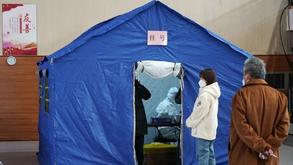 People line up to seek medical advice in a makeshift fever clinic in Guang'an Gymnasium in Beijing, capital of China, Dec 24, 2022. (ZHANG CHENLIN / XINHUA)
People line up to seek medical advice in a makeshift fever clinic in Guang'an Gymnasium in Beijing, capital of China, Dec 24, 2022. (ZHANG CHENLIN / XINHUA)
BEIJING — China has announced that it will be downgrading its management of COVID-19 as of Jan. 8, treating it as a Class B infection, rather than a more serious Class A infection.
Further details on this policy shift were revealed on Tuesday at a press conference of the State Council joint prevention and control mechanism against COVID-19.
The downgrading of COVID-19 management will lead to four main changes in China's epidemic response measures
Li Bin, deputy head of the National Health Commission (NHC), said that various factors have created the conditions necessary for the latest adjustment in the management of novel coronavirus infection.
READ MORE: China: Efforts made to build barrier against COVID-19
He listed the fact that China has closely followed the mutation of the virus, moved fast on vaccination promotion and the supply of medicines, built up its medical treatment and epidemic prevention and control system, and raised its emergency response capacities.
"Currently, with the mutation of the virus, the change of the epidemic situation, the popularization of vaccination and the accumulation of experience in prevention and control, China's epidemic prevention and control has entered a new stage," said Li.
Noting that the adjustment is fact-based and proactive and comes in light of new developments, Li said that "it in no way means letting go of the virus or a complete exit from prevention and control measures."
On the contrary, "China will continue improving management, services and guarantees," said the official.
Liang Wannian, head of the COVID-19 response expert panel under the NHC, said that the adjustment means a shift of focus from infection prevention to medical treatment, adding that efforts should be made to ensure a smooth, orderly transition.
Changes in sight
The downgrading of COVID-19 management will lead to four main changes in China's epidemic response measures, according to Chang Jile, deputy head of the national administration of disease prevention and control.
The country will mainly detect infection cases in the course of providing medical services and via people's self-monitoring, rather than through methods such as mass nucleic acid testing.
Asymptomatic cases and mild cases will be managed at home, instead of being dealt with by treatment and observation in isolation.
Epidemic prevention and control will focus on key locations, institutions and groups of people. Measures including closed-loop transportation and centralized quarantine targeting inbound travelers will be dropped, according to the official.
More medical resources
As the epidemic enters different stages, localities have different requirements regarding medical treatment.
China has taken a wide range of measures to direct the efforts of localities in providing more medical resources and services, in a bid to meet the demands of patients, said NHC official Jiao Yahui.
To better cure severely ill patients, authorities are expanding medical resources for the treatment of such patients and better leveraging the role of primary-level medical care institutions and top grade hospitals.
READ MORE: Easing of regulations heralds new front in COVID-19 battle
Jiao called for strengthened health monitoring for the elderly, saying that those elderly people who are seriously ill could be sent directly to third-grade hospitals for treatment without the bother of multiple referrals.
Pivot of objective
Following the latest adjustment, China's epidemic prevention and control efforts will focus on protecting health and preventing severe cases, said Chang.
China will step up its protection for key demographic groups, including increasing vaccination among elderly people, enhance the medical response at key sectors and venues such as nursing homes, and better manage the medical response at enclosed facilities and large-scale events.
People have been urged to wash their hands more frequently, wear masks properly and be proactive in getting vaccinated.


